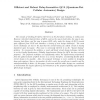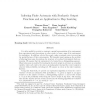221 search results - page 24 / 45 » From MITL to Timed Automata |
DFT
2006
IEEE
13 years 11 months ago
2006
IEEE
The concept of clocking for QCA, referred to as the four-phase clocking, is widely used. However, inherited characteristics of QCA, such as the way to hold state, the way to synch...
AAAI
1992
13 years 8 months ago
1992
It is often useful for a robot to construct a spatial representation of its environment from experiments and observations, in other words, to learn a map of its environment by exp...
IJAC
2007
13 years 7 months ago
2007
There exist two well-known quotients of the position automaton of a regular expression. The first one, called the equation automaton, has first been introduced by Mirkin from th...
RAS
2006
13 years 7 months ago
2006
Self-reconfigurable robots are built from modules, which are autonomously able to change the way they are connected. Such a robot can, through this self-reconfiguration process, c...
ATAL
1995
Springer
13 years 11 months ago
1995
Springer
Abstract. This article considers the link between theory and practice in agentoriented programming. We begin by rigorously defining a new formal specification language for autono...


